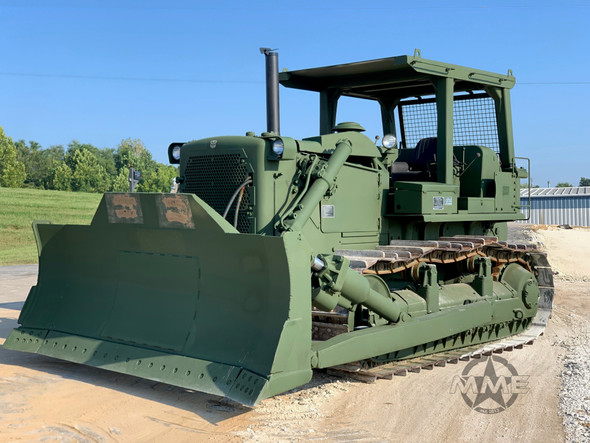

Its knock-down construction with detachable blade and pushbeams made it superior to a standard bulldozer like the WEK7 Bulldozer with its rigid bowl as it permitted easy disassembly for compact stowage or transportation, which is always good for logistics. The XD7 Bulldozer was introduced in 1940. The bulldozer requires only one cable drum, and when operated by a rear-mounted R7 PCU, the spare drum may be used to operate other equipmen. The XD7 Bulldozer can be operated by either LeTourneau front or rear-mounted PCUs. Engaging the clutch of the power control unit will raise the blade, returning the control lever to the neutral position will hold the blade in the raised position, and releasing the brake will lower the blade. LeTourneau XD7 Bulldozer: The LeTourneau XD7 Bulldozer consists mainly of the steel blade or "bowl" across the front of the tractor the pushbeams, which support the bowl in front of the tractor the trunnion brackets, on which the rear of the pushbeams pivots and the front and rear A-frames and the ridgebeam which support the sheaves over which the cable from the PCU travels to raise and lower the blade.The WCK7 angledozer was introduced in 1942 and it became the standard LeTourneau angledozer type for the military D7.Ĭaterpillars D7 with LeTourneau R7 PCU and LeTourneauWCK7 angledozer clearing mud in Italy The WCK7 angledozer required only one cable drum, and when the tractor was equipped with a R7 PCU, the spare drum may be used to operate other equipment. The angledozer bowl could be adjusted into the angled position and into the tilted position. By operating the PCU control-lever, the dozer blade was raised and lowered as the tractor moves forward. LeTourneau WCK7 Angledozer: The LeTourneau WCK7 angledozer was composed of the steel blade or "bowl" across the front of the tractor the yokes and sidearms, which supported the blade in front of the tractor the trunnion brackets, on which the rear of the yoke pivots and the front and rear A-frames and the ridgebeam which supported the sheaves over which the cable from the power control unit passed through to raise and lower the bowl.Notice the curved guards (red arrows) and pointed sharp ends (green),ĭistinctive features of the A7 Tiltdozer blades The left curved guard is missing.Ĭaterpillar D7 with LeTourneau R7 PCU and Seabee Caterpillar D7 tractor with LeTourneau R7 PCU and Notice the pointed sharp ends blade, typical of this blade. The A7 Tiltdozer was introduced in 1943 but it is possible that the U.S.Army did not receive any before 1944.Ĭontrolled by LeTourneau R7 PCU in a Caterpillar D7 tractor. The sharp pointed end blades are a distinctive feature of the A7 Tiltdozers blades. The adjusting mechanism was protected by a curved guard. The adjustment was performed by the blade tilt adjusting-screws, at the front of each tilting brace. The Tiltdozer blade can easily be tilted. Its design combined features of the bulldozer and the angledozer. By releasing the brake, the blade will be lowered. By engaging the clutch of the power control unit, the blade will be raised.

The bulldozer required only one cable drum, and when it is operated by a rear-mounted R7 PCU, the spare drum may be used to operate other equipment. The A7 Tiltdozer could be operated by either LeTourneau front or rear mounted PCUs. LeTourneau A7 Tiltdozer: the A7 Tiltdozer consisted mainly of the steel blade or "bowl" across the front of the tractor the pushbeams, that supported the bowl in front of the tractor the trunnion brackets, on which the rear of the pushbeams pivots and the front and rear A-frames and the ridgebeam on which rotated the sheaves over which the cable from the PCU travels to raise and lower the blade.Moving these control levers, the operater can spool or unspool the control cables on or off the cable drums, thereby operating the various working parts of the equipment being operated by the PCU. Two control levers (one for each drum) extend up behind the tractor seat and are within easy reach for the operator. Control cables (wire ropes) extend from the cable drums to the equipment that is being operated by the PCU. A take-off shaft (spline-shaft) connects the PCU with the tractor upper transmission-shaft, and by the tractor engine. LeTourneau R7 Power Control Unit: the R7 Power Control Unit (PCU) was a double-drum unit mounted on the rear of the steering-clutch case of Caterpillar D7 tractors to control a wide range of equipment like dozers, scrapers, rooters, cranes etc.LeTourneau FTD7 PCU to operate the LeTourneau WCK7 AngledozerĪnd a LeTourneau R7 PCU to operate any towed equipment. Caterpillar D7 of a Naval Construction Battalion (Seabees) with


 0 kommentar(er)
0 kommentar(er)
